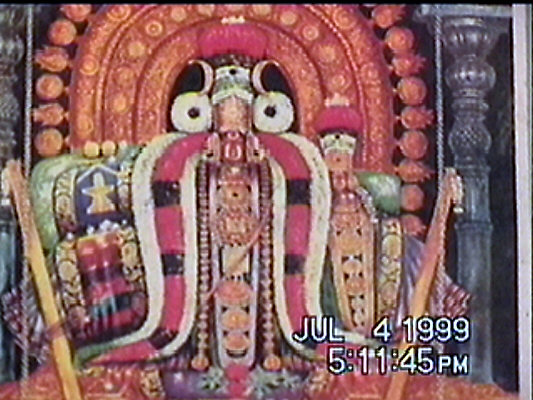Tyagaraja Shrine at
Tiruvarur
Tyagaraja at Tiruvarur (and at the other Saptavitanka
Stalams) represents the Somaskanda
manifestation of Shiva - with Uma and Skanda and is full of symbolism
and mystic significance.
It is to be noted that Somaskanda represents
the processional image of Shiva in most Saivite temples
and there is thus a shrine for Somaskanda in almost all Saivite temples.
The image of Tyagaraja at Tiruvarur is said to have been held in worship
by Mahavishnu and later by Indra the King of the Gods
and then later on by Muchukunda Chakravarti
a valorous king.
The Tyagaraja shrine at Tiruvarur is associated with the Ajapaa Natanam dance which is enacted every time
the deity is taken out in procession.
Raja Raja Chola I who built the Brihadeeswara
Temple at Thanjavur installed a shrine for Dakshina Meru Vitankar
there.
The name Tyagaraja became associated with
Somaskanda only from the 16th century onward (the earliest references to Somaskanda as
Tyagaraja go back to the 12th century CE). Until that point in time, this image was
referred to as Veedhi Vitankar in Tamil and Aaruradipati
in Sanskrit.
Symbolism: Associated with the image of Tyagaraja (The King of Givers)
are symbols such as the manittandu or the sceptre, senkazhuneermaalai
or the garland, ratnasimhasanam or the throne and a sword.
The panchamukha vaadhyam,
the paarinaayanam (nadaswaram) and the suddha
maddhalam drum are special musical instruments associated with this shrine. These
instruments are played during worship services. The aazhitter - or the collossal
chariot and the airavatam elephant are other royal objects
associated with Tyagaraja. Even the Nandi in front of the Tyagaraja
shrine is portrayed in a standing posture.
Mysticsm: There is a sense of mysticism associated with the image of Tyagaraja.
Abhishekam rituals are performed to this image only six times a year, and
even during these occasions the entire image is kept covered with a piece of cloth,
barring the faces of Shiva and Parvati. On a daily basis, abhishekams are
performed to an emrald Shivalingam
placed in the shrine.

Again, the image of Tyagaraja is always
kept covered with decorative cloth, but for the faces of Shiva and Parvati. The feet of
the image are kept uncovered only on two occasions each year - namely Maargazhittiruvadirai and Panguni Uttiram.
The former is referred to as Dakshina Paada Darisanam while the latter is the Uttara Paada
Darisanam corresponding to the darker and the brighter halves of the year.
Also see:
Tyagaraja
Saptavitanka Stalams
The Somaskanda Legend
Somaskanda Iconography
